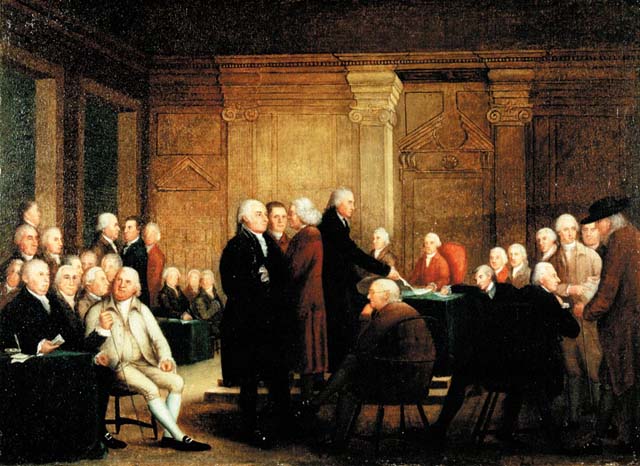Dear Educators,
Let's explore the Second Continental Congress. We aim to provide you with the essential information. This will help you teach this pivotal moment in American history effectively. Think of this document as your guide to the Congress.
What Was It?
The Second Continental Congress convened in Philadelphia. It started on May 10, 1775. This gathering represented thirteen British colonies in North America. The First Continental Congress had already met. However, this second iteration occurred amidst escalating tensions. These tensions eventually sparked the American Revolutionary War. The Congress served as the de facto national government. It did this throughout the war.
Delegates came from each of the thirteen colonies. These included prominent figures like John Adams. Also included were Thomas Jefferson and George Washington. The Congress had a complex set of goals. These goals evolved as the war progressed. Initially, the delegates hoped for reconciliation. They sought reconciliation with Great Britain. However, as fighting intensified, independence became the primary objective. This change was a long and difficult process.
The Congress took on several crucial responsibilities. It established the Continental Army. It appointed George Washington as its commander-in-chief. They also managed the war effort. This included raising funds and procuring supplies. The Congress also engaged in diplomatic efforts. They sought recognition and support from foreign powers. Especially sought was France.
Key Actions and Decisions
One of the Congress's most significant actions was the Declaration of Independence. This document declared the colonies' independence from Great Britain. Thomas Jefferson drafted the declaration. The Congress formally adopted it on July 4, 1776. The Declaration articulated the principles of self-government and natural rights. This resonated not only in America. It also resonated worldwide.
The Articles of Confederation also emerged from the Congress. These established a framework for a national government. The Articles were adopted in 1777. They were ratified in 1781. However, they created a weak central government. This government lacked the power to effectively address national challenges. These challenges included taxation and interstate commerce.
The Congress also played a role in establishing a monetary system. They created a postal service and negotiated treaties with foreign nations. The Treaty of Paris in 1783 was of particular importance. This treaty formally ended the Revolutionary War. Great Britain recognized American independence. It also ceded vast territories to the new nation.
Common Misconceptions
A common misconception is that the Second Continental Congress was a unified body. This is not the case. Delegates held diverse opinions and interests. Debates were frequent. Compromises were often necessary. Understanding this internal dynamic is important. This gives students a more nuanced perspective.
Another misconception involves the Articles of Confederation. Students often assume these were a complete failure. The Articles did have weaknesses. However, they also served a purpose. The provided a framework for governance during a critical period. They also paved the way for the Constitutional Convention. The Convention addressed the limitations of the Articles.
It's also important to clarify the relationship between the First and Second Continental Congresses. The first sought to address grievances with the Crown. The second Congress initially aimed for reconciliation too. However, circumstances forced them to embrace independence. This is a key distinction.
Tips for Educators
To make the Second Continental Congress engaging, consider these tips. Use primary source documents. Excerpts from letters, diaries, and official records bring history to life. Encourage students to analyze these documents. Let them draw their own conclusions.
Role-playing exercises can be effective. Assign students to represent different delegates. Let them debate key issues facing the Congress. This promotes critical thinking. This also encourages empathy. Empathy is for historical figures.
Interactive timelines can help students visualize the sequence of events. Highlight key decisions. These decisions included the adoption of the Declaration of Independence. Also, highlight the creation of the Articles of Confederation. This visual aid makes the information more accessible.
Discuss the challenges faced by the delegates. They faced challenges during the war. These included limited resources and internal disagreements. Examining these challenges fosters a deeper appreciation. This appreciation is for the decisions they made.
Making it Engaging
Incorporate multimedia resources. Videos, images, and interactive maps can enhance learning. These resources can also cater to different learning styles.
Connect the events to contemporary issues. Discuss the enduring relevance of the Declaration of Independence. Explore debates about federalism. This is related to the Articles of Confederation. This helps students see the connections between the past and present.
Encourage students to research individual delegates. Let them present their findings to the class. This promotes independent learning. It also deepens their understanding. This understanding is about the personalities and perspectives of the era.
Consider a debate format. Divide the class into groups. Have them argue for or against key decisions made by the Congress. This encourages critical thinking. This encourages them to develop well-reasoned arguments.
By employing these strategies, you can effectively teach. Teach the Second Continental Congress and its significance. You can also make it engaging. Make it relevant to your students.
In Conclusion
The Second Continental Congress was a pivotal moment. It laid the foundation for the United States. By addressing common misconceptions. Also, by implementing engaging teaching strategies, you can help students grasp. Grasp the importance of this historic gathering. Encourage critical thinking and a deeper understanding of American history. Best of luck in your classroom!

